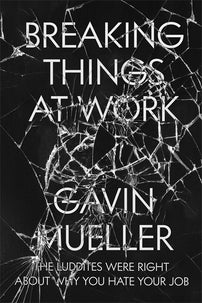Epidemic of Sabotage
Workers should "aim to hit the employer in his vital spot, his heart and soul, in other words, his pocketbook." By Gavin Mueller.

In the United States, which lacked the developed workers’ parties of Europe, an alternate perspective prevailed. The Industrial Workers of the World (IWW), a massive organization of militant and transient workers and unemployed people that tended to prioritize direct action over all else, recognized the implications of scientific management for class struggle. As Taylorist “rationalization” spread through industry, the so-called Wobblies, as Mike Davis tells it, “attempted to develop a rank-and-file rebellion against the rationality of Taylor and the speed-up.”
Amid a heightened interest among workers in militant opposition to the new work methods, the IWW published two remarkable tracts in 1913 on the topic of sabotage. After one of these pamphlets was used to prosecute an organizer, the union withdrew them from publication and publicly renounced sabotage as a tactic. “Sabotage” at this time could mean any number of subversive techniques employed by a worker that interfered with production, including absenteeism, work slowdowns, “working to rule” by following only explicit requirements of the job, even striking. It could refer to disrupting equipment— “the displacement of parts of machinery or the disarrangement of a whole machine”—but it could also mean creating better quality products than owners intended. As leading IWW member Walker C. Smith wrote,
The workers are coming to see that their class is the one to whom adulterated food, shoddy clothing and rotten materials are sold, and by refusing to adulterate products they not only destroy the employers’ profits but safeguard their own lives as well.
In fact, he argued with a note of irony, “sabotage” could even describe the actions of employers when they halted production by locking out workers.
Smith argued that the benefits of sabotage were twofold. First, it had a direct economic impact on capitalists: “The aim is to hit the employer in his vital spot, his heart and soul, in other words, his pocketbook.” Second, and more important, it was a means of developing militancy and solidarity among workers. Smith likened its effects on class struggle to those of guerilla warfare:
Guerilla warfare brings out the courage of individuals, it develops initiative, daring, resoluteness and audacity. Sabotage does the same for its users. It is to the social war what guerillas are to national wars. If it does no more than awaken a portion of the workers from their lethargy it will have been justified. But it will do more than that it will keep the workers awake and will incite them to do battle with masters. It will give added hope to the militant minority, the few who always bear the brunt of the struggle.
Sabotage techniques drew from the specific placement of workers within a production process, “a weapon which the masters cannot wrest from them.” And if, like guerilla warfare, it was a weapon of the weak, then Smith admitted as much:
Is it not true that the workers are still largely without consciousness of power? It would be suicidal to act on the theory that we are today clothed with the might for which we are struggling. Being weak we must guard our embryonic organization, using every means within our grasp save that of compromise with our enemy, the employing class.
Legendary IWW activist Elizabeth Gurley Flynn attempted a more precise definition in her tract: “sabotage” referred to any effort “to limit his production in proportion to his remuneration,” or in other words, “the deliberate withdrawal of efficiency by a competent worker.” Rather than argue, as Smith did, for the salutary effects of sabotage for class consciousness, Flynn argued that workers already engaged in sabotage all the time, but without having a consistent name for what they were doing. Flynn quotes a worker at the Paterson silk mill in New Jersey, where organizers debated the efficacy of sabotage during the 1913 strike:
I never heard of this thing called sabotage before Mr. Boyd spoke about it on the platform. I know once in a while when I want a half-day off and they won’t give it to me I slip the belt off the machine so it won’t run and I get my half day. I don’t know whether you call that sabotage, but that’s what I do.
As Flynn noted, “one member of the executive committee after another admitted they had used this thing but they ‘didn’t know that was what you called it!’” Flynn’s analysis of sabotage was, in this sense, eminently Marxist: rather than dictate strategy in a top-down manner, she conceptualized the actually existing tactics of workers as a fundamental component of class struggle. “We are to see what the workers are doing,” she wrote, “and then try to understand why they do it; not tell them it’s right or it’s wrong, but analyze the condition.”
A few years later, the themes and ideas from these infamous Wobbly tracts appeared in a somewhat surprising place: one of the major works of the unorthodox American sociologist Thorstein Veblen. Veblen’s The Engineers and the Price System is most famous for his sketch of a technocratic socialist transformation in the United States. But the book opens with a somewhat odd discursus on, of all things, sabotage. Veblen reiterates the arguments of Smith and Flynn to such a degree that he must have had their work in mind. He even uses Flynn’s definition of sabotage: “the conscientious withdrawal of efficiency.”
Like the Wobblies, Veblen expanded the definition of sabotage to include techniques used by manufacturers in the course of business:
Such manoeuvres of restriction, delay, and hindrance have a large share in the ordinary conduct of business; but it is only lately that this ordinary line of business strategy has come to be recognized as being substantially of the same nature as the ordinary tactics of the syndicalists.
Many scholars have viewed Veblen’s analysis as part of his characteristic ironic approach to criticizing the capitalists of his day, and such a tone is clearly evident. But Veblen’s discussion of sabotage also reflects his engagement with the IWW and their politics, which lasted for years. As economic historian John F. Henry describes, Veblen had a great deal of sympathy for the IWW, signing petitions against their persecution and going so far as to recommend that the American Farm Bureau hire out-of-work Wobblies to work the fields. The latter suggestion prematurely ended his career at the Department of Agriculture.
While Veblen likely shared the IWW’s antipathy to capitalism, he did not approve of their methods. In describing the epidemic of sabotage committed by both workers and owners, he sought not to valorize the side of the workers, but to posit a mediating figure: the engineer. Veblen argued that engineers, whom he classified with the “common men” of the workforce rather than the “vested interests” of the capitalists, had “begun to become uneasily ‘class conscious’” due to “a growing sense of waste and confusion in the management of industry by the financial agents of the absentee owners.” With their “common interest in productive efficiency, economical use of resources, and an equitable distribution of the consumable output” rather than profit and competition, engineers would be the worthy inheritors of the United States’ industrial capacity, which they could run for the common good. They would form a “soviet of engineers.”
Veblen died before he could do much more work on this front, but he inspired others to carry the torch of creating a more egalitarian society out of new technologies and restructured labor processes. One of the most influential and long-lasting think tanks dedicated to a society rationally administered by technical experts was organized by Howard Scott, a fast-talking engineer who had occasionally collaborated with Veblen.
In the 1920s, Scott had been the research director of the IWW, studying waste in the capitalist system; in 1932, with engineering professor Walter Rautenstrauch, he formed the Committee on Technocracy at Columbia University. Like Veblen, the Technocrats criticized the “price system” they saw as the root problem with capitalism, arguing instead for a currency system based on “energy units,” a plan that was never fully explained. Even amid these somewhat crankish schemes, Technocracy reached the zenith of its influence in the early 1930s as the Great Depression shattered faith in the existing economic system and sent people looking for answers to what would come next.
Technocracy’s diagnosis of the capitalist system sounds remarkably like the predictions of today’s Fully Automated radicals: that a social crisis was upon us, caused by the substitution of machines for laborers. As the Technocrats avowed in their eponymous magazine, from ditch digging to adding machines,
one machine after another has been or is being perfected to take the place of the worker. It is, however, obvious that it is only a question of time when machines will have displaced so many workers that an entirely new system of providing the people of the earth with a living must be devised.
What would this system look like?
***
This is an extract from Breaking Things At Work: The Luddites Were Right About Why You Hate Your Job, by Gavin Mueller, and part of the Verso Roundtable on the book.
[book-strip index="1" style="display"]


